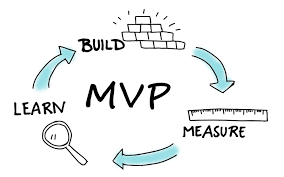Minimum Viable Product or MVP is a development technique in which a new product is introduced in the market with basic features, but enough to get the attention of the consumers. The final product is released in the market only after getting sufficient feedback from the product’s initial users.

What is a minimum viable product (MVP)?
The minimum viable product, or MVP, is the simplest version of a product that you need to build to sell it to a market. The concept of the minimum viable product, or MVP,
“The version of a new product which allows a team to collect the maximum amount of validated learning about customers with the least effort.
Minimum Viable Product or MVP is the most basic version of the product which the company wants to launch in the market. It could be a car, website, TV, or a laptop. By introducing the basic version to the consumers, companies want to gauge the response from prospective consumers or buyers.
This technique helps them in making the final product much better. With the help of MVP concept, the research or the marketing team will come to know where the product is lacking and or what are its strengths or weaknesses.
MVP has three distinct features. One is that it will have enough features for consumers to purchase the product (it becomes easier for the company to market it), the other is that it will have some sort of a feedback mechanism wherein users would be able to send their feedback about the product. And, lastly it should have enough future benefits for consumers who to adopt the product first (Google gave free upgrade of its OS to all Nexus users).
The idea is to get feedback from the consumers which will in turn help in making the desired changes in the final product. MVP actually tests the usage scenario rather that is much for more helpful for the company to make changes to the final product.
What is the Purpose of a Minimum Viable Product?
- Release a product to the market as quickly as possible
- Test an idea with real users before committing a large budget to the product’s full development
- Learn what resonates with the company’s target market and what doesn’t
In addition to allowing your company to validate an idea for a product without building the entire product, an MVP can also help minimize the time and resources you might otherwise commit to building a product that won’t succeed.
The importance and benefits of implementing MVPs
The concept of an MVP comes from lean startup methodology, which encourages learning and building with scalability in mind. So with an MVP, you’re building the first small step at a low risk to your wallet and business that you can test, refine, and grow step-by-step. You’ll start with that small step to uncover the market’s interest in your product — this will teach you where you need to make improvements, scale back, or perhaps even add extra features to make the product marketable.
The benefits of focusing on an MVP and scaling it up may vary, but ultimately the purpose is to provide a low-risk testing ground before you invest thousands (or millions!) of dollars into a product before it’s ready to sell. MVP testing can provide cost savings, insights into user-centered design, fast business launches, and even getting early investor buy-in. The insights and investment you’ll reap early on will help you build the dream product you and your customers have been looking for.
Setting up an effective MVP
1. Identify the customer pain points
What problem are you trying to solve? Let’s get into the minds of Uber founders Garret Camp and Travis Kalanick way back in 2008. Let’s say you are attending a conference in a big city and you notice it can be difficult to hail a cab late at night or in bad weather. So you want to build a solution where you can just use your phone to get a ride home. You talk to potential users and ask them what their preferences are: do they expect to hail a cab at the touch of a button? Would they be comfortable texting a taxi driver to get home? How do they prefer to pay for their ride? This way, you do your market research to get an idea of who would use your solution and what they would expect from it.
Take your research and interview results and validate them with data. This will give you a better understanding of your customers’ needs and pain points, identify which features your product needs at a minimum to provide value, and give you some good testimony you can use as proof of concept during the investment stage.
From their preliminary research, Camp and Kalanick developed “UberCab,” the first edition of the popular Uber app we know today. The MVP was a version based entirely within SMS, giving users the ability to call a cab through a simple text. The rest, as they say, is history.
2. Describe the competitive landscape
If the year is 2006, your cab-hailing service probably has few competitors. But in 2023, ride-sharing services are abundant, with plenty of overlap from app to app. What will make your service stand out? What are customers still missing out on? And what’s the monetary value of those pain points to the customer? Come up with a pros and cons list that showcases how your service does it better than the competition.
3. Test the MVP for validity
Identify a beta group or internal testers from your team who can give the basic technology a try, whether it’s a landing page, an SMS line (like early Uber), or a basic one-page app. Stick to deadlines and have your testing team focus on the functionality and the ability to solve pain points. This will help you ideate and understand where you need to improve and refine the product before you launch it to early adopters.
4. Get ready to launch
If your MVP gets past the testing stage, congrats! You’ve got something special. Now it’s time to research, build, test, fix, launch, and continue ideation. Once you’ve solidified the few features you identified from the start,
FAQs
Evolving beyond MVPs?
The MVP isn’t the end-all-be-all for your business. In fact, the concept of the MVP has evolved to more refined solutions, like the Minimum Lovable Product (MLP) or Minimum Marketable Product (MMP).
The Minimum Lovable Product (MLP) is a customer-centered product that users love from the start, defined by its features offering the minimum a product needs to be loved. Lovability here hinges on the customer experience, where the product or service directly addresses the problems customers have that they want to be solved. The MLP might have an existing market and competitors, but this is the preferred alternative due to its cost-savings, better solutions, or ease of use. With an MVP, the priority is getting to market as fast and affordably as possible. With an MLP, the priority is delivering the highest value to the customer.
What are some examples of MVPs?
Amazon
In the early 90s, Jeff Bezos read that the e-commerce industry would be the next big venture in sales and took the opportunity to discover which markets would be most successful. He eventually landed on a bookstore as the minimum viable product, which he ran from his garage. The success of his bookstore led to the demand for other products, like electronics, clothing, and shoes. It was his first step — using books as the MVP — that gave him the customer insight to take Amazon to the next level. Who would have thought that a small bookstore on a basic webpage would expand to the third-largest enterprise in the world in just 20 short years?
Uber
Yes, the ride-sharing app we all know and love didn’t start as a mobile app. In fact, founders Garret Camp and Travis Kalanick took advantage of the idea of an MVP to develop an iPhone-only SMS service called UberCab in San Francisco. They tested the user experience and refined it within the city before they were able to gather venture capital and build the app that services 19 million trips around the world each day.
Uber has gone through various iterations, increasing its scope year by year using the feedback collected from its customer base. While UberCab launched with just taxis, Uber in its second wave incorporated black cars and independent contractors as drivers to build the ridesharing experience we all know and use today. Through various iterations, we’ve seen Uber expand way beyond the MVP to include pooled rideshare, accessible ride options, and in some small markets, even helicopters.
